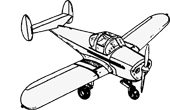Ercoupe History
ERCO stands for "Engineering Research Corporation" whose first product was the Ercoupe. This was the first production tricycle aircraft and was designed by Fred Weick. Fred is famous for many things, including the NACA cowling and the standard "takeoff/landing over a 50-foot obstacle" specification. He went on to design the Piper PA-28 Cherokee and other well-known airplanes.
The first JATO (Jet Assisted Take Off) was tested on an Ercoupe which led to the foundation of the Jet Propulsion Laboratory.
The Ercoupe, with its distinctive twin-tail design, was originally provided with "coordinated controls", i.e. the rudder was connected to the yoke and yaw correction was automatic - it had no rudder pedals. The steerable nose wheel was connected directly to the yoke - you taxied exactly like you drive your car. This, and limited up elevator travel, contributed to the result that the 'Coupe is "characteristically incapable of spinning!" You can try, but the plane will fly out of an incipient spin. An entirely new category of pilot license was created for the thousands of new pilots who had never seen a rudder pedal.
This plane was designed pre-WWII and didn't get into real production until 1945 when thousands were sold through such esteemed aviation outlets as the Men's Department at Macy's.
"Rudder Kits" were available to convert the plane from 2-control ("coordinated") to 3-control ("conventional").
Landing a 2-control 'Coupe is an "interesting" experience! You crab it into the wind and land that way. The nose wheel will turn and straighten it out on the runway. Another historical fact: all original Boeing 707 pilots were taught to land in the 'Coupe - the 707 had a similar problem - the low hanging engines meant that you couldn't drop a wing into a crosswind - you had to land them crabbed. [ed note: The Ercoupe's main gear does not swivel, a common misconception, but the geometry causes the airplane to turn in the direction of forward motion. If you fight this tendency you can ground loop.]
The plane was built by a series of manufacturers including ERCO, Sander, Forney, Alon and Mooney. Mooney built the last 59 with a "Mooney tail" instead of the distinctive twin tail of all previous production. This, and other changes, created an airplane which could stall and spin with the best but also lost a lot of performance. It was their intention that the M10 Cadet be their "trainer".
"Alon" was an interesting bit of history: While Forney was building the 'Coupe, one company which came mighty close to buying the type certificate was Beech. John Allen (the Beech plant manager) and Lee Higdon (the Beech accounting manager) felt strongly that Beech should take it on, but Olive Beech got cold feet and said no. So they quit and setup the Allen-Higdon (ALON) company to do it. They were so impressed with the plane that they bought the company. Alon made a number of speed/power changes to the airplane and reverted to providing rudder pedals as standard, with the 2-control by special order only. They changed from vertically sliding window entry to a sliding canopy.
Some people dump on 'Coupes. It's unfair and ignorant criticism, but it keeps the prices down and the secret in the family. If you ever have to opportunity to fly a 'Coupe - try it!
[ed additions: The Ercoupe has climb and cruise performance very similar to the performance of a Cessna 150 - but it drops like a rock when the power goes off. The best thing about a 'Coupe is you can fly it with the sliding windows down (see pictures on my home page). My windows go down in April and stay down until Halloween.
The 415-C and -CD models have a gross weight of 1260 lbs and therefore may be flown by pilots with only a Sport Pilot license. It is the only standard category aircraft to meet these requirements that is not a taildragger. As such, the price on these models has skyrocketed since the Sport Pilot license was created.]
Michael Gillespie (michaelg <at> gray.mb.ca)
President, The Gray Research Group
Alon A2 Aircoupes CF-XVI, CF-VCH, C-FDBF, CF-WDZ
